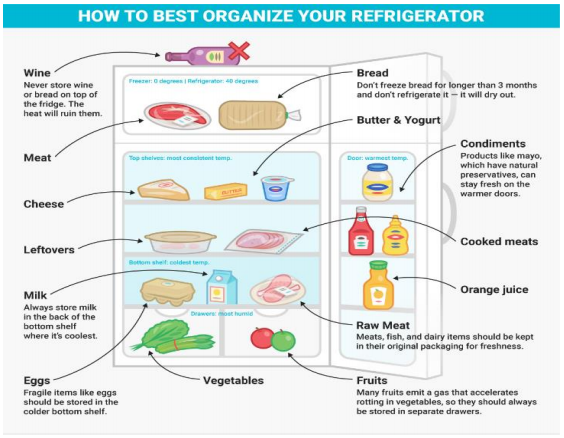Guidance for Home
GUIDELINES FOR HOME
- Shop Smartly
- Plan meals in advance
- Use Grocery lists
- Avoid impulsive buys
- Be Realistic
- Buy exactly what you need. Avoid unnecessary stocking up the goods.
- Place foods in the proper storage area (refrigerator or freezer) quickly to avoid bacterial growth
- Freezer – frozen foods, vegetables and meats, precooked frozen meals, ice creams and ice.
- Refrigerator – fruits, vegetables, cheese, milk, meat, fish, poultry, eggs, cooked food: leftovers
- Cool Places – oils and fats, canned foods.
- Room temperature – cereal and pulses, root and tubers, bananas, spices and condiments.

- Don’t over peel
- Peeling of fruits and vegetables should be done carefully and over peeling should be avoided as it creates food waste.
- Storage
- An overview about some of the food products storage conditions and their use by dates:
Category of food Type of food Product Use before(At Room Temperature) Use before(At Refrigerated Temperature) Perishable Food Milk ( Pasteurised) 5-6 hours 5-6 days Cut Fruits and Vegetables 24 hours 1-2 days Yogurt 1-2 days 2-3 days Cheese 1-2 days 4-5 days Meat and poultry 1-2 days 5-6 days Fish 1-2 days 4-5 days Eggs 7-10 days 2-3 weeks Fresh fruits and vegetables 1-2 days 3-4 days Cooked food 4-6 hours 12-24 hours Milk ( UHT ) 5-6 months 6-7 months Flour 1-3 months 2-6 months Grain 4-6 months 10-12 months Semi Perishable Food Potatoes 1-2 weeks 2-3 months Onion 1-2 months 2-3 months Garlic 3-5 months 10-12 months Ginger 7-10 days 1 month Baked Foods 2-4 days 7-14 days Dry Fruits 5-6 months NA Sugar 6-7 months NA Non-Perishable Food Dried beans 5-6 months 10-15 months Spices 6-7 months NA Canned foods 1-2 years 4-5 years Salt 6-7 months NA
- An overview about some of the food products storage conditions and their use by dates:
- Reuse leftovers
- Excess food should be stored at optimum temperature for later use.
- Example: pickles, salads, lemon etc., after storing in refrigerator can be reused as flavoring agents if left earlier.
- Monitor what you throw
- Throw only unavoidable food waste items eg; - scraps, peels etc;
- Keep a strict watch over what you are throwing and thus act accordingly to reduce food waste.
- While having Meal
- Check in your belly: Take a moment to ask your body what and how much it wants to eat.
- Clean your plate:Before leaving the dining table, ensure your plate is clean i.e.; no leftovers.
- Educate others: Make family members aware about the issue of food loss and this will make them more attentive to waste less.
- Don’t over-serve:
Over-serving will lead to generation of leftovers therefore it should be avoided.
- Organize Dinner / Party of surplus food
- In case food is available in excess, organize dinner/party for neighbors/ friends so that wastage of food can be prevented.
- Use it up all
- Have a plan B to use all the surplus food by preparing new dish or feed for pets before it gets expired.
- Look for recipes on websites that can be searched for by ingredients to use up food at home.
- Community Kitchens
- A group of people who meet on regular basis can plan, cook and share healthy, affordable meals. These kitchens thus enable the development of food independence skills such as food growing and harvesting, meal planning, budgeting, food preparation and cooking.
- Preserve food
The various actions of micro-organisms result in the loss of edibility or nutritive value of food. By canning, pickling or drying, the life span of some foods can be increased.
- Drying:This process acts by reducing the moisture content in the food which in turn arrests bacterial growth. Drying can be done either by direct exposure to sun, using dryer or oven. Fruits and vegetables can also be preserved by this method.
- Freezing:Micro-organisms require a certain level of temperature for their survival. Freezing foods lower the temperature to levels that make the environment unsuitable for microbial growth. Low temperatures can be achieved by using freezer.
- Canning:In this process, the food is first processed and then sealed in airtight containers. While themicro-organisms are killed by processing the food, their entry and proliferation is restricted by canning it in an airtight environment.
- Pickling:Cucumber, beef, peppers and some vegetables may be preserved by pickling. This technique involves dipping the food in some liquid chemical that prevents the growth of micro-organisms but still maintains edibility of the food. The preserving liquids used are vinegar, brine, alcohol and some other oils.
- Donate Food
Donate what you won’t use- Donate it to a food kitchen/ local food bank organizations before it expires so it can be consumed by someone who needs it.
- Donate the gross stuff, too!- Club together in a colony to jointly collect the gross stuff and donate it to environment friendly waste disposal techniques.
Note: The unaccepted food can be used in various environment friendly waste disposal techniques.